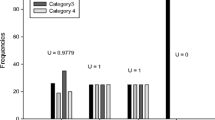Abstract
It was proposed earlier (Crow, 1977) that variability may be a unifying behavioral concept. The present paper is an update on one aspect of that earlier proposal, response variability, including recent evidence bearing on the issue. In addition, a neural model of behavioral variability is presented to account for the findings and to suggest further avenues of research.
Similar content being viewed by others
References
ANTONITIS, J. J. (1951). Response variability in the white rat during conditioning, extinction, and reconditioning. Journal of Experimental Psychology, 42, 273–281.
CROW, L. T. (1977). Is variability a unifying behavioral concept? The Psychological Record, 27, 783–790.
CROW, L. T. (1982). Ethanol-induced response stereotypy: Simple alternation, fixed-interval rates of response, and response location. Bulletin of the Psychonomic Society, 1, 169–172.
CROW, L. T., BENDT, V. A. H., & TRACY, D. M. (1982). Mutually antagonistic effects on behavioral variability of ethanol and an aversive Cs +. Bulletin of the Psychonomic Society, 20 263–265.
CROW, L. T., & HART, P. (1983). Alcohol and behavioral variability with fixed-interval reinforcement. Bulletin of the Psychonomic Society, 21, 483–484.
CROW, L. T., & MCWILLIAMS, L. S. (1979). Relative stereotypy of water-ingestive behavior induced by frontal cortical lesions. Neuropsychologia, 17, 393–400.
CROW, L. T., MCWILLIAMS, L., & LEY, M. (1979). Relative stereotypy of water-ingestive behavior induced by chronic alcohol injections in the rat. Bulletin of the Psychonomic Society, 14, 278–280.
CROW, L. T., & SPRING, W. (1984, May). Effects of substantia nigra lesions in the rat on ethanol-induced reduction of behavioral variability. Paper presented at the meetings of the Pacific Cascade Chapter of the Society for Neuroscience, Timberline Lodge, OR.
DEVENPORT, L. D. (1983). Spontaneous behavior: Inferences from neuroscience. In R. L. Mellgren (Ed.), Animal cognition and behavior. Amsterdam: North Holland Press.
DEVENPORT, L. D., DEVENPORT, J. A., & HOLLOWAY, F. A. (1981). Alcohol and the hippocampus: Mutual antagonism of performance. Alcoholism: Clinical Experimental Research, 5, 147.
DEVENPORT, L. D., & MERRIMAN, V. J. (1983). Ethanol and behavioral variability in the radial-arm maze. Psychopharmacology, 79, 21–24.
DEVENPORT, L. D., MERRIMAN, V. J., & DEVENPORT, J. A. (1983). Effects of ethanol on enforced spatial variability in the 8-arm radial maze. Pharmacology Biochemistry and Behavior, 18, 55–59.
FRICK, F. C., & MILLER, G. A. (1951). A statistical description of operant conditioning. American Journal of Psychology, 64, 20–36.
KESSLER, J., & MARKOWITSCH, H. J. (1983). Perseverative effects of parabrachial lesions: A mechanism of reduced activation? Behavioral and Neural Biology, 39, 40–51.
LEMOAL, M., CARDO, B., & STINUS, L. (1969). Influences of ventral mesencephalic lesions on various spontaneous and conditioned behaviors in the rat. Physiology and Behavior, 4, 567–573.
LURIA, A. R., & HOMSKAYA, E. D. (1964). Disturbance in the regulative role of speech with frontal lobe lesions. In J. M. Warren & K. Akert (Eds.), The frontal granular cortex and behavior (pp. 353–371). New York: McGraw-Hill.
MEREU, G. P., & GESSA, G. L. (1982, October). Ethanol increases the firing rate of dopaminergic neurons. Paper presented at the meetings of the Society for Neuroscience, Minneapolis, MN.
PRIBRAM, K. H. (1960). The intrinsic systems of the forebrain. In J. Field (Ed.), Handbook of physiology: Vol. 2, Neurophysiology. American Physiological Society, Washington, DC.
PRIBRAM, K. H. (1961). A further experimental analysis of the behavioral deficit that follows injury to the primate frontal cortex. Experimental Neurology, 3, 432–466.
RANDRUP, A., & MUNKVAD, I. (1967). Stereotyped activities produced by amphetamine in several animal species and man. Psychopharmacologia (Berlin) 11, 300.
SCHWARTZ, B. (1980). Development of complex stereotyped behavior in pigeons. Journal of the Experimental Analysis of Behavior, 33, 153–166.
SIMPSON, B. A., & IVERSON, S. D. (1971). Effects of substantia nigra lesions on locomotor and stereotyped responses to amphetamine. Nature, 230, 30–32.
STAMM, J. S. (1963). Function of prefrontal cortex in timing behavior of monkeys. Experimental Neurology, 7, 87–97.
STAMM, J. S. (1964). Function of prefrontal and cingulate cortex in frustrative behavior. Acta Biologica Experimentia (Warsaw) 24, 27–36.
TASMAN, A., & SIMON, R. H. (1983). Effect of midbrain stimulation on amphetamine-induced stereotypy in rats. Psychopharmacology, 79, 364.
TOLPYSHEV, B. A., & SERGEEV, M. V. (1981). Effect of stimulation and destruction of substantia nigra on amphetamine and apomorphine-induced stereotypy in cats. Farmakologiia I Tok-sikologii (USSR), 44, 550–554.
WARREN, J. M. (1964). The behavior of carnivores and primates with lesions in the prefrontal cortex. In J. M. Warren & K. Akert (Eds.), The frontal granular cortex and behavior (pp. 168–191). New York: McGraw-Hill.
Author information
Authors and Affiliations
Rights and permissions
About this article
Cite this article
Crow, L.T. More on Variability as a Behavioral Concept. Psychol Rec 35, 293–300 (1985). https://doi.org/10.1007/BF03395851
Published:
Issue Date:
DOI: https://doi.org/10.1007/BF03395851




